Home to superlative landscapes rich with glassy lakes, shimmering glaciers, and the granite hulks of the Paine Massif, there’s a reason Torres del Paine National Park has become Chile – and Patagonia’s – landmark protected area.
But planning a trip to this national park can feel complicated, to say the least. Whether you’re looking to backpack the five-day W trek, the nine-day O circuit or instead spend a few days in a hotel in the park day hiking or enjoying a multi-sport programme of activities, trying to organize the logistics of a visit to Torres del Paine can start to overwhelm.
Luckily, I’ve visited the national park on three occasions: to hike the W, then the O Circuit and, most recently, to stay at multiple hotels and enjoy some of the other activities you can find here. As a result (and thanks to my work as the sole author of Moon Chile), I’m an expert on the local area.
This article aims to answer the key questions you have about visiting Torres del Paine National Park and links out to other articles on the site that explore each topic in even greater detail – thus guiding you through the planning and booking process and setting you up for an unforgettable trip.
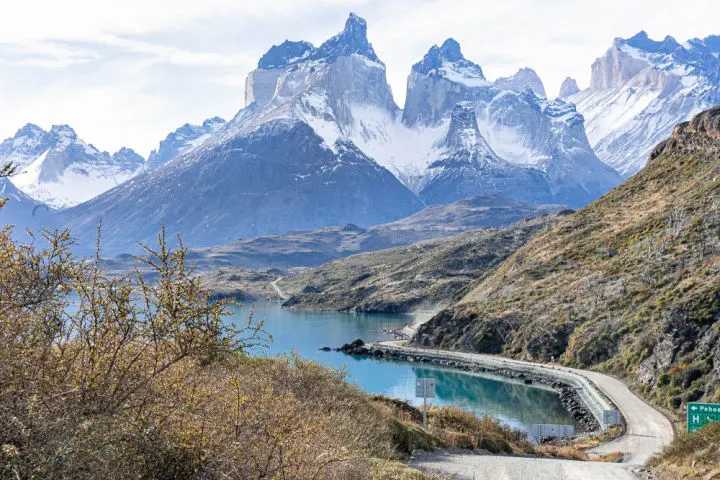
As one of the most incredible destinations in Patagonia, it’s a place in which you’ll find yourself hoping to spend even longer – so this guide should help you spend your time most efficiently in the park.
Where is Torres del Paine National Park?
Torres del Paine National Park lies in the far south of Chile, in the Magallanes region. It’s located 47 miles (75 kilometres) from Puerto Natales and a further 318 kilometres (198 miles) from Punta Arenas, the region’s only city.
It’s also part of Chilean Patagonia, a region (not a country) that covers the southern stretches of both Chile and neighbouring Argentina.
Planning Your Trip to Patagonia?
Save time, stress & money with a customized travel itinerary planned for you by a Patagonia expert
How much does it cost to visit Torres del Paine National Park?
The cost of entering the park varies according to how long you plan on staying. For up to three days in the national park, it costs $35 USD for adults and $17 USD for children aged 12 to 17. For over three days in the park, the cost is $49 USD for both adults and children.
You must book your entrance ticket before you enter the park using this website. You need to download the QR code in Puerto Natales while you have internet (there is no signal in the park) and may need to show a copy of your passport to prove you do not live in Chile.
How can you get to Torres del Paine National Park?
There are various different ways to reach Torres del Paine National Park, depending on whether you’re coming from Chile or Argentina.
From Santiago, Chile
To get to Torres del Paine National Park from the Chilean capital, Santiago, you first need to fly to Puerto Natales. Note that there aren’t always direct flights, particularly outside of the main summer tourism months (December through February); you may find flights have a stop in Puerto Montt. These cost from $240 USD (including checked luggage).
Alternatively, you can fly from Santiago to Punta Arenas, a city 150 miles (242 kilometres) and a 2.5-hour drive or bus journey south of Puerto Natales. Flights to Punta Arenas are more frequent and you should find direct departures multiple times daily. These cost from $150 USD (including checked luggage).
The best place to check flights is using Skyscanner; be aware prices rarely include checked luggage. I recommend making reservations directly with the airlines in case you need to make changes to your booking – this can be difficult with third-party aggregator websites.
To get from Punta Arenas to Puerto Natales, you can either drive north along Ruta 9 or take a public bus. These leave more-or-less hourly, with companies Bus Sur and Buses Fernández offering this route (costs $10,000 CLP/$10 USD).
A final alternative is to take a public ferry to Puerto Natales. The four-day, three-night Navimag ferry is a service that departs from Puerto Montt (at the northern tip of the Carretera Austral or a 13-hour bus journey or two-hour flight south of Santiago). Accommodation is in comfortable cabins, with all meals included.
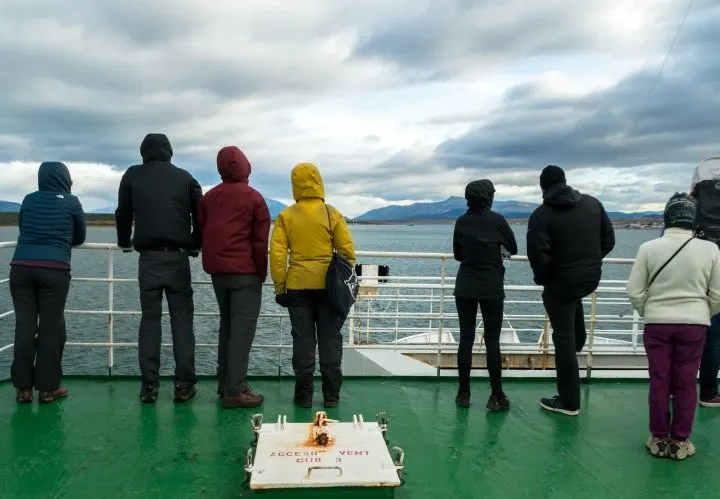
From the deck and the windows of bedrooms and the lounge area, you can admire the sublime scenery of the Patagonian fjords as you head south alongside the Carretera Austral and then deeper into Southern Patagonia.
A second alternative is the 41-hour TABSA ferry from Caleta Tortel (at the bottom of the Carretera Austral), which similarly takes you down through the fjords into Southern Patagonia. Accommodation is far more basic; you get a 160° reclining chair in an open room with other passengers, while food is provided (if a little scant in terms of portion size).
From Puerto Natales, Chile
Puerto Natales is the closest town to Torres del Paine National Park and sits 47 miles (75 kilometres) south.
Because of this, it’s highly likely that you’ll need to spend at least one night in Puerto Natales before traveling to Torres del Paine National Park.
We’ve written a whole guide to Puerto Natales hotels, so check that out before you arrive in Patagonia.
By bus
The easiest way to get to Torres del Paine National park is from Puerto Natales. Twice daily, two different companies provide public bus services into the national park, with tickets costing from $10,000 CLP/$10 USD one-way or $15,000 CLP/$14 USD round-trip.
Their schedules are as follows:
Bus Sur: From Puerto Natales to Torres del Paine National Park
| Pick up/drop off point | Departure one | Departure two |
| Terminal Rodoviario, Puerto Natales | 7am | 12pm |
| Laguna Amarga, TDP | 9am | 2pm |
| Pudeto, TDP | 10am | 3pm |
| Camping Pehoé, TDP | 10.15am | 3.30pm |
| Administración, TDP | 11am | 4pm |
| Hotel Lago Grey, TDP | 11.30am | 4.30pm |
Bus Sur: From Torres del Paine National Park to Puerto Natales
| Pick up/drop off point | Departure one | Departure two |
| Hotel Lago Grey | 1.30pm | 5pm |
| Administración | 2pm | 5.30pm |
| Camping Pehoé | 2.15pm | 5.45pm |
| Pudeto | 2.30pm | 7.15pm |
| Laguna Amarga | 3pm | 7.45pm |
| Terminal Rodoviario | 4.30pm | 9.30pm |
Find the most up-to-date schedules for Bus Sur here.
Turismo Zaahj: From Puerto Natales to Torres del Paine National Park
| Pick up/drop off point | Departure one |
| Terminal Rodoviario, Puerto Natales | 6.45am |
| Laguna Amarga, TDP | 8.45am |
| Pudeto, TDP | 9.45am |
| Camping Pehoé, TDP | 10am |
| Administración, TDP | 10.45am |
| Hotel Lago Grey, TDP | 11.15am |
Turismo Zaahj: From Torres del Paine National Park to Puerto Natales
| Pick up/drop off point | Departure one |
| Hotel Lago Grey | 4.45pm |
| Administración | 5.15pm |
| Camping Pehoé | 5.30pm |
| Pudeto | 7pm |
| Laguna Amarga | 7.30pm |
| Terminal Rodoviario | 9.15pm |
Find the most up-to-date schedules for Turismo Zaahj here.
By car
You can hire rental vehicles either in Punta Arenas (where there is plenty of stock and prices are lower) or in Puerto Natales (where there is much-reduced stock, so cars are booked up very quickly).
I recommend Rental Cars as they give you insurance documents in English. Bear in mind you need additional insurance if you plan on crossing into Argentina; organise this with your rental company at least a few weeks in advance and expect to pay around $100 USD for this.
The national park has two main entrances:
- Portería Serrano: located in the south of the park and accessed by the Y-290. It is the closest entrance to Puerto Natales. However, the road to enter here is not fully paved, so most traffic (including the public buses) enter the national park via the other entrance. It does, however, have the best views of Los Cuernos (the mountains at the heart of the Paine Massif) as you drive north through the park.
- Portería Laguna Amarga: located in the east of the park and accessed by the Y-150/Y-156. It is the closest entrance to El Calafate, but is also accessible from Puerto Natales. This road is fully paved and therefore is the quickest route into the park from Puerto Natales. The scenery isn’t as impressive as entering the park via Portería Serrano.
From Buenos Aires, Argentina
To reach Torres del Paine National Park from Buenos Aires, the Argentine capital, you will need first to reach El Calafate, the closest Argentine town. It lies 258 kilometres (160 miles) and a 3.5-five-hour drive northeast of the national park, via the Paso Río Don Guillermo border crossing.
To reach El Calafate, there are at least five daily flights from Buenos Aires, which can cost from $205 USD (including checked luggage).
Because there is less competition between airlines, domestic flights within Argentina can typically be double the price of those in Chile.
From El Calafate, Argentina
From El Calafate, you can either drive, take public transport or opt for a direct private transfer.
By car
Drive directly from El Calafate to Paso Río Don Guillermo by heading south down Ruta 40 (a 2.5-hour, 127-mile (204-kilometre) drive). The border crossing can take over an hour during busy periods during the high travel season (November through March) and you will need additional insurance from your rental company to take an Argentine car across the border.
From the border, it’s a one-hour, 55-kilometre (34-mile) drive to reach Portería Laguna Amarga along the Y-150 and Y-156.
Bear in mind there is only a gas station located here between El Calafate and Torres del Paine National Park. Bring US dollars or Argentine pesos as it’s unlikely they will accept cash.
By bus
Take a bus from El Calafate to Puerto Natales, which is operated by Bus Sur and Turismo Zaahj, with typically two/three morning departures (7am-8am) and one afternoon departure (3.30pm). These buses can take five to seven hours, depending on delays at the Chilean border and cost around $25,000 CLP/$26 USD.
From Puerto Natales, take the public bus into the national park (see above).
By private transfer
A more direct option is a transfer with South Road. These are part of a day trip to visit the national park, so are a great choice if you only want to visit for the day.
They’re also a good choice if you’re trying to reduce the amount of time it takes to get from El Calafate to Torres del Paine, however, this option is very expensive, costing $200 USD. Because this tour explores the national park, you’ll also have to adapt your plans within Torres del Paine to match their schedule.
For example, this tour doesn’t reach the east of the park where the O Circuit and the hike up to the torres (towers) begins until mid-afternoon.
When’s the best time to visit Torres del Paine National Park?
Torres del Paine National Park is open all year round, however hiking conditions are best during the summer months (December through February) and the shoulder season (October/November and March/April).
During these months, you can visit Torres del Paine independently without hiring a licensed guide. Outside of these months, you are required to visit the national park with a licensed guide.
While climatic conditions are very hard to predict in Patagonia (it’s not uncommon to experience four different seasons in one day!), you can generally expect the following weather:
Torres del Paine National Park in spring: September, October and November
As the snow beings to clear in Torres del Paine National Park, the official hiking season begins. Bear in mind that if you’re visiting during the month of September, you will need to be accompanied by a licensed hiking guide.
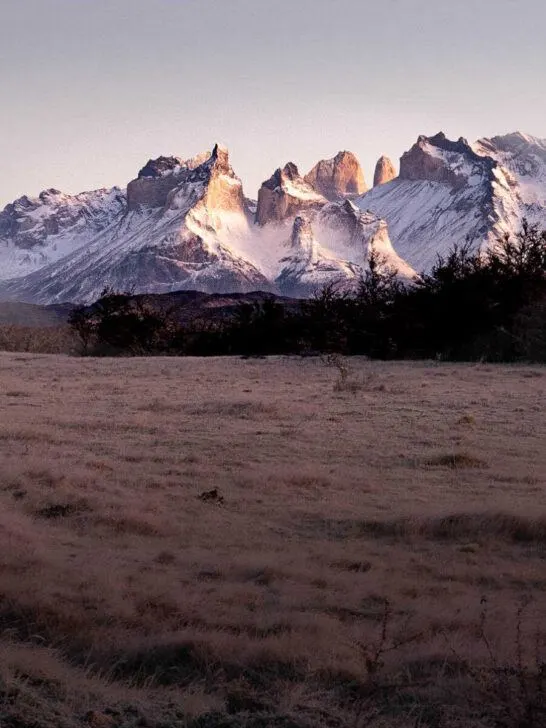
During these months, highs average around 16°C (60°F) and can drop to 3°C (37°F) at night – so bring plenty of layers, including thermal underwear, if you plan on camping in the national park. Winds are also much weaker during these months (they reach their strongest in the summer).
This is the second quietest season within Torres del Paine, so it’s a brilliant time to visit if you want to see Patagonia in her quiet splendour or want to hike up to the torres (towers) at dawn (which can be as late as 7am). However, as spring moves towards summer, the number of visitors does increase.
Torres del Paine National Park in summer: December, January and February
The austral summer is when Torres del Paine National Park is at its busiest. The bulk of visitors enters the park between the months of December and February when you can expect temperatures to hit 20°C (68°F), and drop to 8°C (46°F) overnight.
Dawn is much earlier, so if you’re planning on hiking up to the torres (towers) from Torres Central (four hours) or Chileno (two hours), then you can expect an early start.
As this is the peak time for tourism, you will need to make camping or refugio reservations for the W trek and the O Circuit, as well as any hotel reservations within the national park, at least three months in advance.
For example, as of August 2022, practically all reservations for December and January were taken for both treks and hotels within the national park. Reservations are now open for the 2023/24 season. Save yourself a tonne of time and book through Torres Hike rather than the complicated mess that are the Vertice Patagonia and Las Torres websites (trust me, I had to do the latter and it was long-winded).
Torres del Paine National Park in autumn: March, April and May
The second shoulder season, the months of March, April and May see the high visitor numbers of the summer begin to dwindle. This is accompanied by a fall in temperatures to highs of 13°C (55°F) during the day and -3°C (27°F) at night.
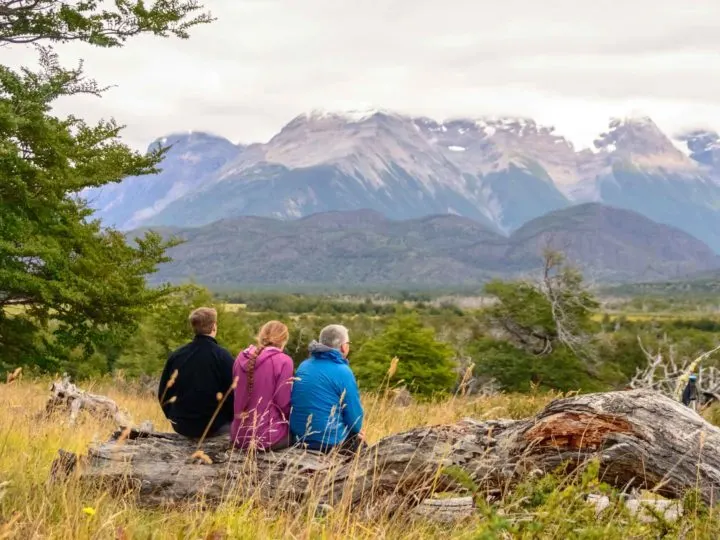
From the end of April, you will need a licensed guide if you wish to do any of the W trek in the park or attempt any of the other day hikes in the park, while the O Circuit can close to hikers at the end of March.
Torres del Paine National Park in winter: June, July and August
As winter sets in, the national park falls quiet, with few tourists. During this period, you must have a licensed guide with you if you plan on hiking in the park and only a handful of hotels and campgrounds are open. The O Circuit is completely closed to hikers, while for the O, you will need to organise a tour with a local operator (we recommend Chile Nativo – mention Worldly Adventurer and you’ll get a 5% discount on your tour).
Despite the higher costs of visiting during winter, Torres del Paine is at its most bewitching, blanketed with snow and empty of visitors. Bear in mind that high temperatures hover around 8°C (46°F) and drop to -3°C (27°F) at night, so you’ll want thermal underwear and plenty of warm layers for hiking.
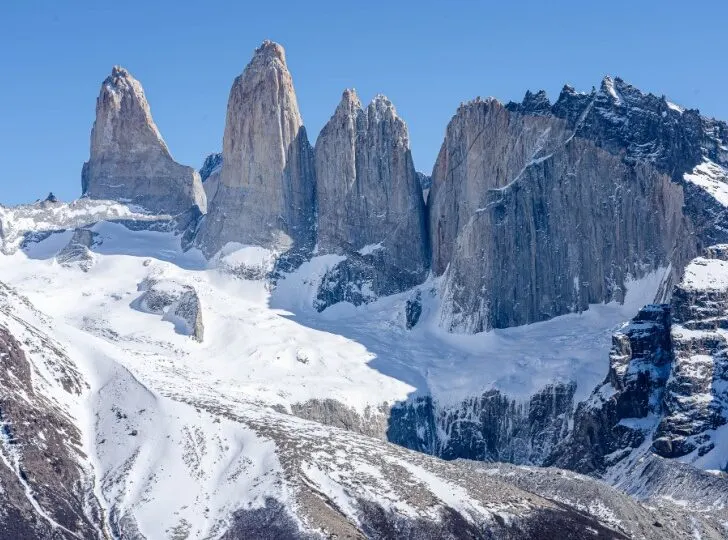
Most tourist services, such as hotels, tours (aside from the W) and some restaurants are closed during this period and flights can get cancelled due to poor weather, so ensure you’ve got plenty of slack in your itinerary and pre-book hotels in advance.
Read more about the best times to visit Patagonia.
How many days should you spend in Torres del Paine National Park?
It depends.
If you’re planning on hiking the W trek, you’ll want a minimum of four days/three nights in the park (although most people tend to complete it in five days/four nights).
For the O Circuit, you’ll need a minimum of eight days/seven nights (although, again, people may choose to do this hike at a slower pace).
If you’re going to be staying in an all-inclusive hotel with tours included, or rent a vehicle and explore the national park independently, it’s best to have at least three or four full days in the park.
Remember, it takes around 1.5 hours to drive into the national park from Puerto Natales or a least 3.5 hours from El Calafate, so factor that into your plans.
What is the elevation of Torres del Paine National Park?
While the Paine Massif, the mountains at the centre of the national park, might form part of the Andes Mountain Range, they’re not actually as high as you might expect.
If you’re hiking the W trek, the highest elevation you’ll meet on the trail is 900 metres (2,950 feet) at Laguna Torres and the Mirador Las Torres.
For the O Circuit, you’ll summit the Paso John Gardner (John Gardner Pass) at an altitude of 1,241 metres (4,071 feet). As a result, there are no concerns about altitude sickness or the requirement to acclimatise when visiting Torres del Paine.
The top 11 things to do in Torres del Paine National Park
From hiking through spellbinding scener, to puma tracking and exploring relics of ancient cultures past, there are plenty of activities to do in Torres del Paine and, surprisingly, it’s not just a paradise for avid hikers.
1. Hike the W trek
The best-known activity and most popular hike within Torres del Paine is the W trek, a five-day/four-night hike that takes you to the park’s most striking locations. Named after the shape the trek follows, the W is a brilliant introduction to multi-day hiking.
Well-marked paths with plenty of footfall and the possibility of hiring an already pitched tent or a bed in a cosy dorm plus meals at each campground make this hike easy enough to attempt by yourself without a guide or heavy camping equipment, too.
It also explores what many consider to be Torres del Paine’s finest terrain, including epic views of Glacier Grey, which calves icebergs into the frosty waters of Lago Grey, as well as the possibility of spotting rare huemul deer in the Valle Francés (French Valley) and, if the weather is good, Mirador Britannico (British Viewpoint).
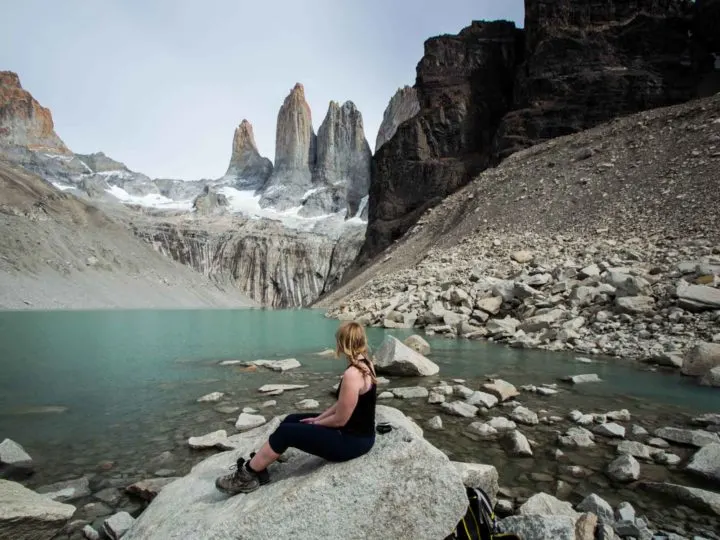
But the cherry on top for most hikers is the final day’s trek up into the Ascencio Valley to reach Mirador Las Torres, the park’s trademark viewpoint of the three-pronged granite torres (towers) after which the park is named and which sit majestically above a glassy, glacier-fed lake.
Covering 46 miles (74 kilometres) in total, this is a challenging hike, but one that many first-time trekkers successfully achieve. You can read our full guide to planning the W trek for more information.
Reservations are now open for the 2023/24 season.
2. Hike the O Circuit
For more serious hikers, or those who want to see Patagonia as pristine and quiet as possible, the typically nine-day/eight-night O Circuit is an extended version of the W and my preferred trail. With a cap of 70 hikers per day on this path, the first three days before you join the W are blissfully quiet and a glorious way to connect with Patagonia’s wild landscapes.
This trail starts from Laguna Amarga in the east of the park and heads in a loop (hence the name, O) around the back of the Paine Massif – the mountains that sit at the very centre of the national park.
With a lot more climbing, including up to the 1,241-metre (4,071-feet) Paso John Gardner for panoramic views of Glacier Grey from above, and covering a distance of 136-kilometre (85-mile) this trek is more challenging than the W, but worth the extra exertion.
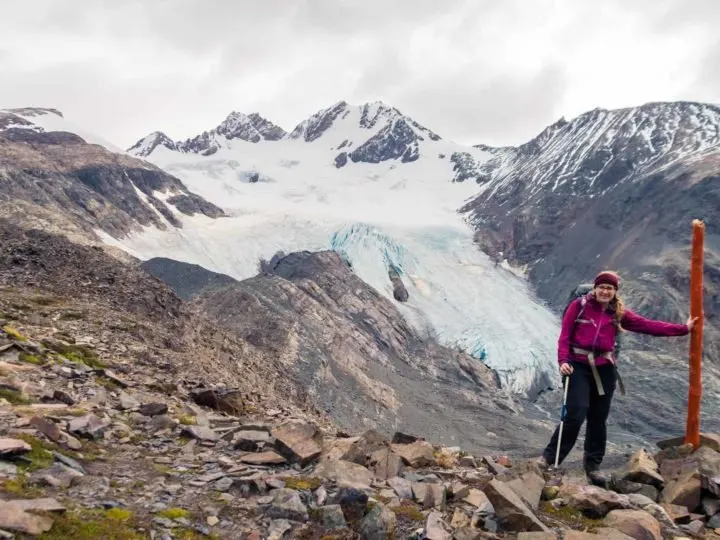
As with the W trek, you can even rent all food and camping gear along the trek, meaning you can hike this trail with just a day pack or you can opt to carry all your camping gear and food.
For more details about hiking the O Circuit, read our comprehensive guide to hiking the O, learn what to pack for the O Circuit, what food to bring for a multi-day hike and find out the things you need to know before you head out onto the trail.
Reservations are now open for the 2023/24 season.
3. Hike sections of the W
Only have a couple of days in the park or can’t get reservations for campgrounds along the W? Some of the key parts of the W trek can be explored as part of day hikes, whether you’re staying within the park or at lodging further away in Puerto Natales.
The most famous is the hike up to Mirador Las Torres, the viewpoint for the park’s namesake towers. It’s a challenging trek: 16 kilometers (nine miles) return and with an altitude gain of 750 meters (2,460 feet), it’ll take between seven and nine hours, but it’s more than work the effort, particularly at dawn when the light turns the three granite towers a deep orange color.
You can also explore other sections of the W on a day hike. The easiest is the section from Paine Grande refugio and campground into the Valle Francés (French Valley), a trail that takes you beneath the shadows of Los Cuernos and up into the glacier-fringed valley.
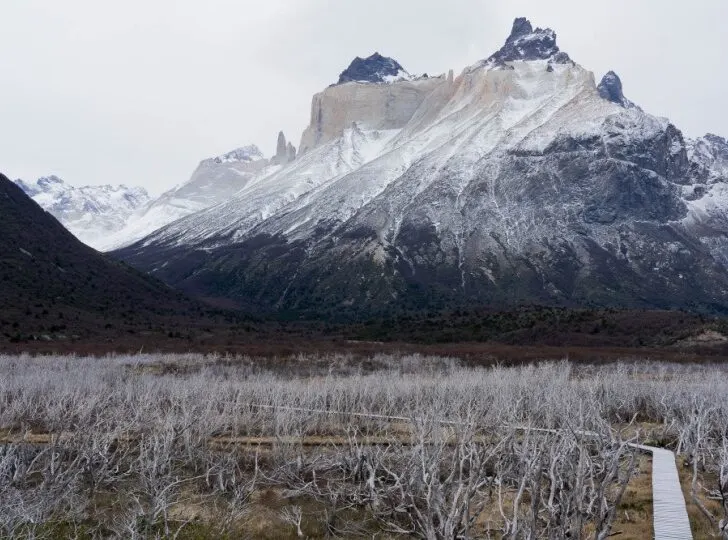
Weather can affect your views on this trek, as low cloud gripping the tops of the Paine Massif can prevent you from seeing much at all once you reach Mirador Francés and head deeper towards Mirador Britanico.
But the views back across the national park, over the wind-whipped waters of Lago Nordenskjöld can be remarkable, whatever the weather.
For logistical information about hiking each of these treks, head to our guide to day hikes in Torres del Paine National Park.
4. Hike shorter day hikes across the national park
Don’t fancy a full-day hike in the glorious scenery of Torres del Paine National Park? No problem; there are plenty of short hikes to keep you busy and experiencing the park’s stunning landscapes.
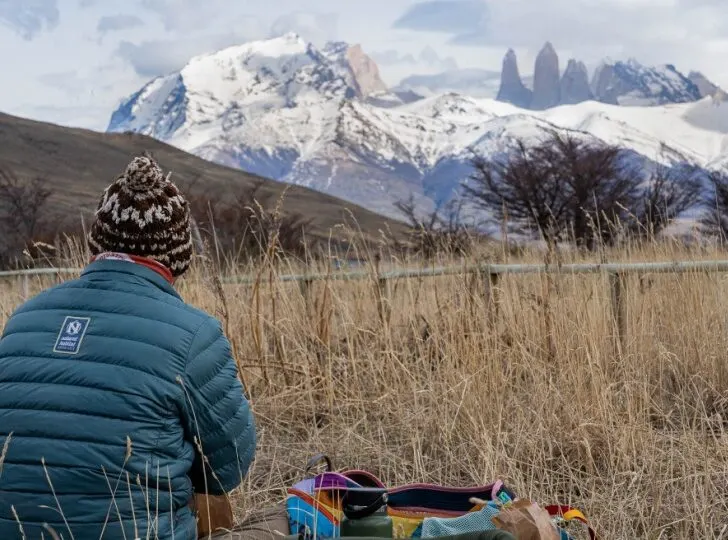
If you want to catch a view of the torres (towers) at the heart of the national park but don’t have the time or energy for an eight-hour hike, head east to Laguna Azul, a lake on the very edges of the national park from where you can hike a short trail towards the north of the national park or just admire the views of the torres from the lake itself.
Though they’re partially concealed because of the angle, it’s one of the best views you can get without approaching them directly on foot.
Other hikes can grant you equally spellbinding views of other key Torres del Paine landmarks. For example, the five-kilometre (three-mile) round-trip hike from the Pudeto catamaran stop to Mirador Cuernos grants panoramas of Los Cuernos, perhaps the most enchanting of all the prongs of the Paine Massif.
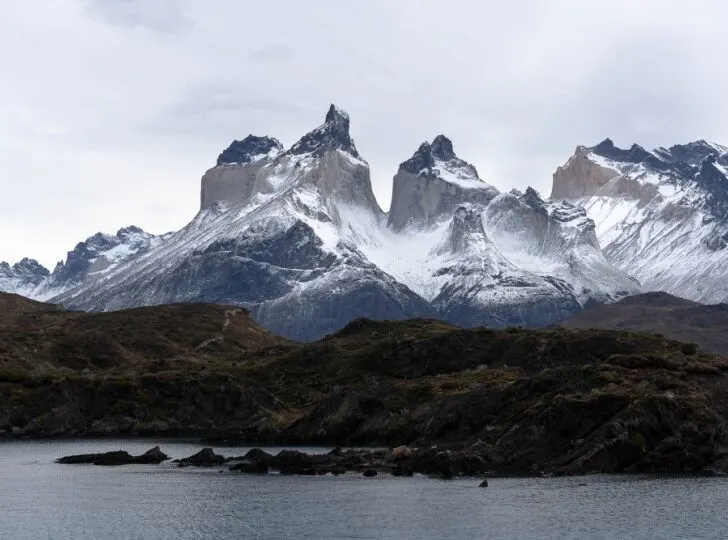
The lung-bustlingly steep, four-kilometre (2.5-mile) round-trip hike up to Mirador Ferrier, right next to Hotel Lago Grey, promises truly spectacular vistas across the entire park from its elevated position
Strap on your hiking boots and read everything you need to know about the best day hikes in Torres del Paine National Park.
5. Breathe in striking viewpoints around Torres del Paine
If mobility is an issue or you’re just not much of a hiker, you can still appreciate the majesty of the national park.
A rental car or a day tour from Puerto Natales (such as this one) will allow you to cover a number of the different key viewpoints, which include Mirador Nordenskjöld (possibly the most dramatic of the viewpoints), Mirador Condor (a true photographer’s favourite) and Mirador Pehoé (another ubiquitous view of the national park’s mountains, the Paine Massif).
Find logistical information about these viewpoints and how to reach them in this post about day hikes and viewpoints in Torres del Paine National Park.
6. Go puma tracking
On my first-ever trip to Torres del Paine National Park back in 2016, I came a whisker away from seeing a puma in the campground at Torres Central when I was hiking the W.
Since then, puma numbers have soared, with the national park now estimated at having the highest density of pumas on the planet – and perhaps even 200 individuals calling this area home.
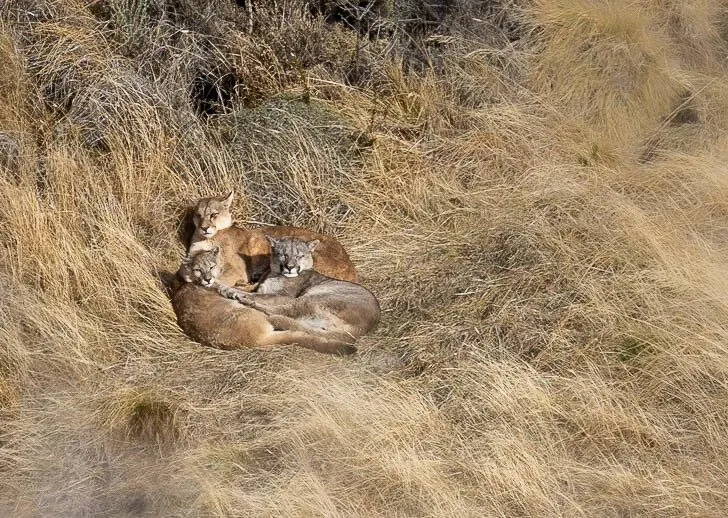
While there’s a chance of spotting one while hiking any of the park’s trails (and, if you do, maintain a safe distance), the closest you’ll get to a guaranteed sighting is by heading on a puma tracking tour. I went out into the park with Chile Nativo, their top puma guide and a local rancher turned puma spotter.
The results? A brief encounter watching two pumas on a failed attempt at hunting a pack of guanaco, followed by an hour spent watching a mum and her two cubs cuddling in the long grass in another section of the park.
Puma tracking doesn’t come cheap at $895 USD per person for this two-day tour, but this does include a night in Chile’s Nativo’s rustic but still comfortable Riverside Camp, plus really delicious, traditional meals. You can also secure a 5% discount by adding “Worldly Adventurer” to the referral discount box when you book!
7. Explore the powder blue crevasses of Glacier Grey with an ice-trekking tour
Another of the park’s most striking sights is Glacier Grey. This hunk of millennial ice wallows on the edges of Lago Grey, connected to the Southern Patagonia Ice Field by 28 kilometres (17 miles) of compacted ice split apart with crevasses and ice caves that disappear beneath the glacier’s surface.
One of the best ways to encounter this hidden world is by taking an ice trekking tour. You’ll either need to be hiking past Grey refugio and campground along the W or O Circuit treks or need to take a boat out across Lago Grey (see #10) to reach the start of this tour, which is operated by ice trekking experts BigFoot Patagonia.
It takes five hours, with around one hour of that spent on the ice. Learn more about the tour (which costs $180 USD and is only available between October and April) and book it here.
8. Dodge icebergs and kayak through the park
Another way to get up close and personal with Glacier Grey is with a kayaking trip across Lago Grey. There are two main tours on offer, both operated by BigFoot Patagonia.
The first starts from Grey refugio and campground and takes you padding through icebergs calved from the snout of the glacier, before heading back in the same direction you came. This trip takes around 2.5 hours, costs $100 USD and is available between October and April.
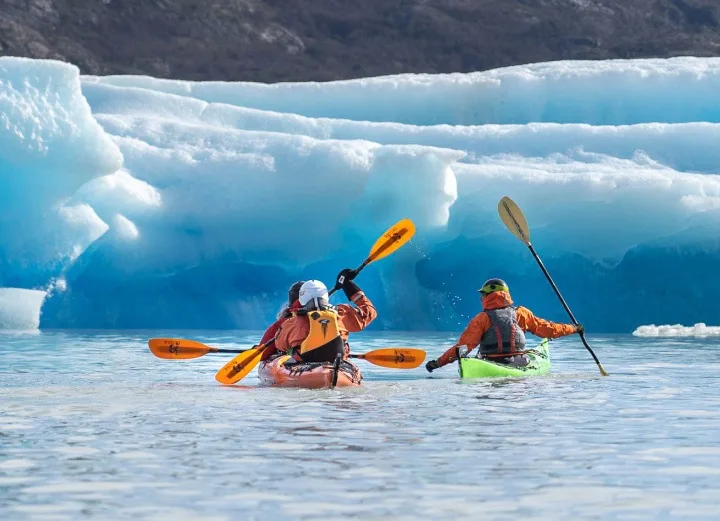
An alternative is a half-day kayaking trip starting out from Hotel Lago Grey and paddling up to the icebergs as they float down Lago Grey, before following the route of the water as it flushes into Río Grey and wiggles south through the national park.
Not only do you get close enough to icebergs to touch them, but commanding views of Los Cuernos are part and parcel of the experience – plus the chance to see the park from an unusual angle: the water.
This tour takes around three hours, costs $275 USD and is available all year round.
9. Sail out to Glacier Grey
If soft adventure is more your cup of tea, boarding the catamaran ferry from the beach beside Hotel Lago Grey out to the very skirts of Glacier Grey may well be more your pace.
While you’re required to walk for around 15 minutes from the hotel to reach the ferry, this trip allows you to absorb views of the Paine Massif, with Los Cuernos in the background and Lago Grey in the foreground, from the comfort of the boat.
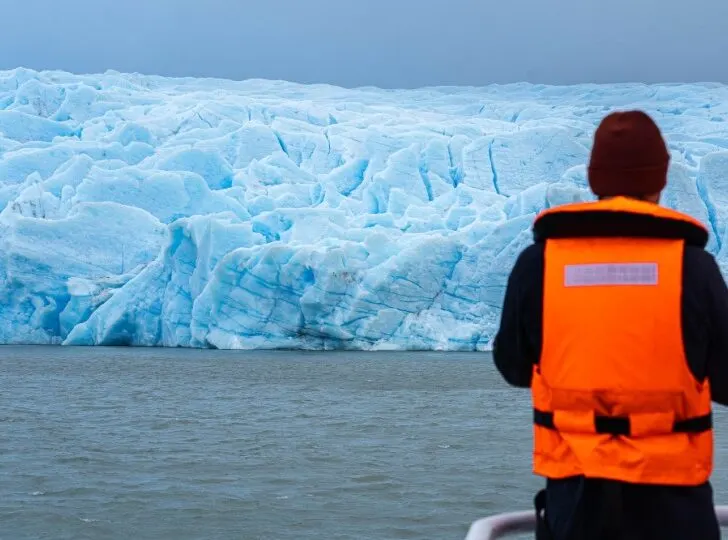
You’ll sail up to the edges of the glacier, watching as it calves bus-sized icebergs into the lake’s milky blue waters if you’re lucky, and sample a pisco sour shaken with glacier ice as the boat heads back to dry land.
The boat isn’t the cheapest but allows for very close views of the glacier that are otherwise only possible for those hiking one of the multi-day trails or kayaking on Lago Grey. There are normally four boats a day and you can also use this boat to drop you off at Grey refugio and campground if you want to start the W trek from there rather than at Paine Grande.
For boat schedules and to reserve your place on the ferry go here and consider booking a night at Hotel Lago Grey to absorb the fine views of the lake, too.
10. Spend a day horseback riding
Patagonia’s relationship with horses stems back over a hundred years when colonisers flocked to this remote region to toil the land, founding ranches for sheep farming to fulfil the demand for raw wool in Europe.
Ranch hands soon became incredibly skilled riders and the ranches around Puerto Natales and in Torres del Paine date from this period, with many now open to tourists keen to learn more about the region’s history and have a go on horseback.
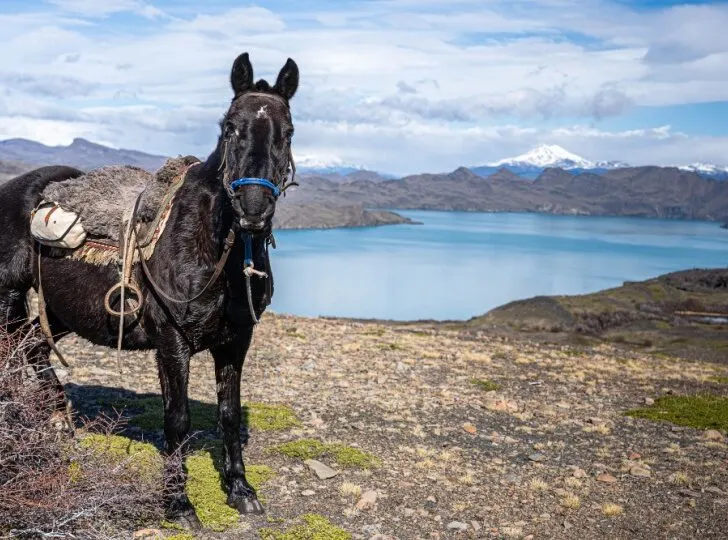
One of the best places to do it is at Hotel Las Torres, right beneath the trailhead for the hike to the torres (towers).
Owned by the Kusanovic family, whose former ranch turned conservation area sits right within the national park, Hotel Las Torres’ stables shelter over 200 horses, which are looked after by a team of baqueanos (Patagonian cowboys).
They can take you out along horse-only trails to absorb the scenery surrounding Lago Nordenskjöld and even up into the mountains opposite Mirador Las Torres for an alternative perspective of the torres (towers).
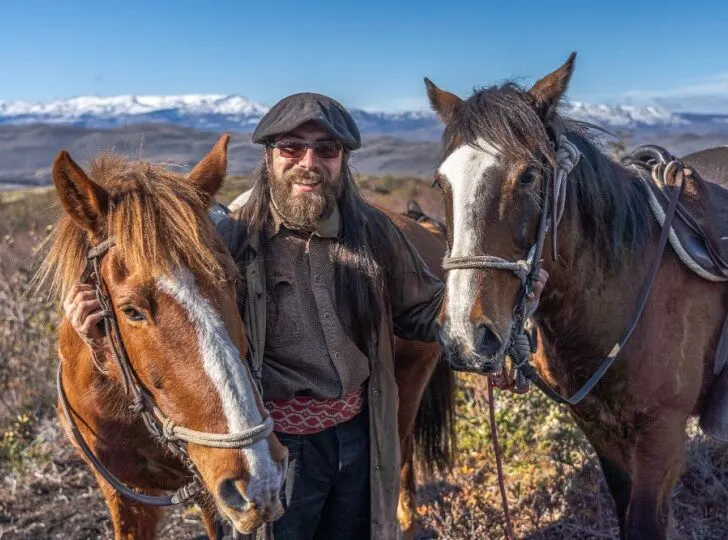
Find out more about their tours here and book a stay at Hotel Las Torres (a great option for a night of relaxation post-W trek or O Circuit).
11. Visit an authentic local estancia (ranch)
Keen to learn more about the traditional sheep farming culture of the region? Head to Cerro Guido, a working ranch turned hotel on the eastern outskirts of the national park.
With 50,000 sheep on 90,000 hectares (222,000 acres of land) – of which 2,000 hectares (2,900 acres) are now dedicated to conservation and puma research – this ranch is a fascinating place to learn about the region’s history.
There’s also a brand-new boutique hotel and exquisite dining options and views of the torres directly from the dining room window.
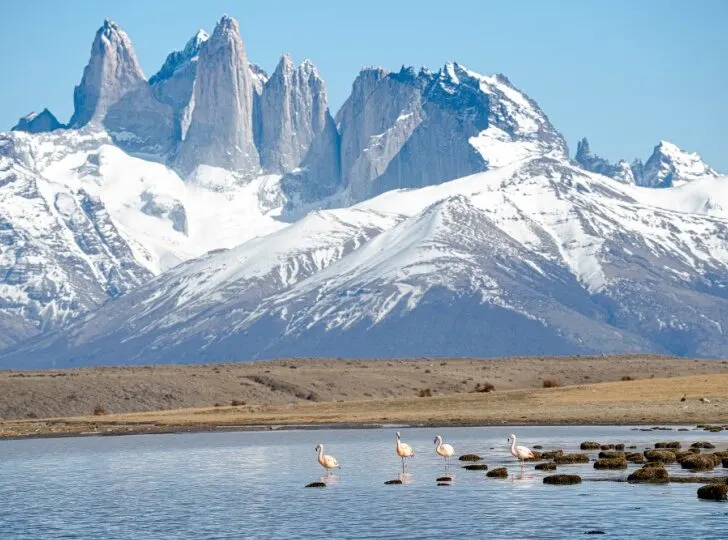
Wildlife safari tours, where you learn about the ranch’s conservation efforts and have a chance to spy puma, flamingo, foxes and guanaco, cost $320 USD (learn more here), while all-inclusive lodging in their brand-new hotel rooms start from $790 USD (including all meals) and can be booked here.
Where to stay in Torres del Paine National Park
You might be surprised to learn that accommodations in Torres del Paine National Park don’t just take the form of basic refugios or campgrounds. In fact, everything from sustainable yurts to luxurious, five-star hotels are available within the park, with accommodations available according to all budgets. That said, prices are elevated compared with hotels in other parts of Chile and Patagonia.
Reservations for accommodation in the park also are snapped up very quickly, so aim to book your accommodation at least four to six months in advance of your planned travel time, particularly if you’re hoping to visit the park between December and February.
Here are some of the best places to stay in Torres del Paine National Park.
The best all-inclusive accommodation in Torres del Paine
If you’ve only got a couple of days in the park or just want all of the logistics to be organised for you, your best option is to consider an all-inclusive hotel or tour package. These can be expensive but allow you to explore the national park during the day and head back to comfortable lodgings and high-quality dining in the evening.
Patagonia Camp
Situated just outside the Portería Serrano entrance to the national park in the south, Patagonia Camp ($1,800 USD double all-inclusive, three-night minimum) has 20 centrally-heated, luxury yurts tucked into old forest and dotted across a hillside overlooking Lago del Toro and the dazzling Paine Massif, with Los Cuernos at its heart, beyond.
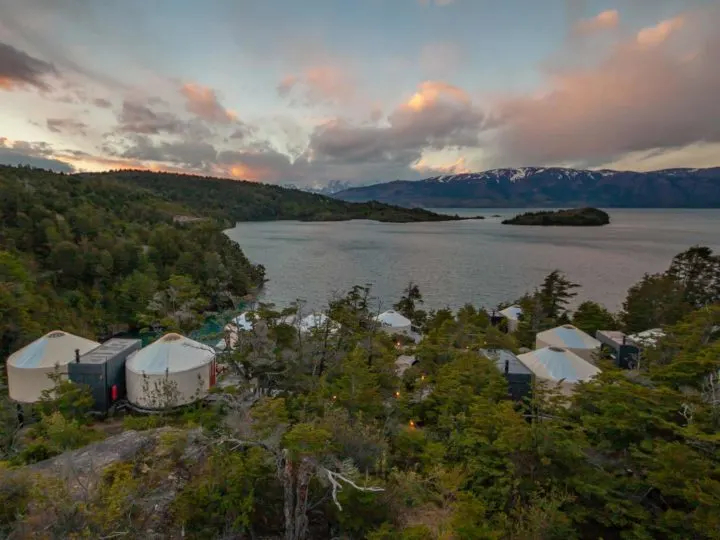
The views are dramatic and the hospitality first class. A ratio of two staff per guest ensures attention feels personalised, while the restaurant (which has similarly incredible views from its cosy interior) cooks up a storm with delicately presented dishes inspired by Patagonian and Chilean classics. Best of all, meals are paired with the owners’ award-winning wine from the organic Matetic Winery just outside of Santiago.
Kayaking and hiking can be organised directly from the hotel, while you can explore the whole park with their guides by selecting from a wide menu of excursions, which are included in the price. Choose a yurt with a jacuzzi (11 have this luxury!) for a stint of relaxation – just with an outstanding view – at the end of each day.
The best hotel accommodation in Torres del Paine
If you’ve hired a car and want the freedom to explore the national park self-guided, but still want a comfortable place to rest your head after a busy day hiking, staying in one of the park’s hotels is the ideal choice.
Prices are much higher than what you can expect to pay in the rest of Patagonia, but views across the national park from many of the top options are outstanding.
Río Serrano Hotel + Spa
Located right on the banks of the Río Serrano and just a 10-minute drive south of the Portería Serrano entrance, the large Río Serrano Hotel + Spa ($765 USD double all-inclusive) is the most upscale but still affordable lodgings in this part of the national park. Opt for a Superior room for the best views in the house: right across the national park to Los Cuernos’ hulking lumps of jagged granite.
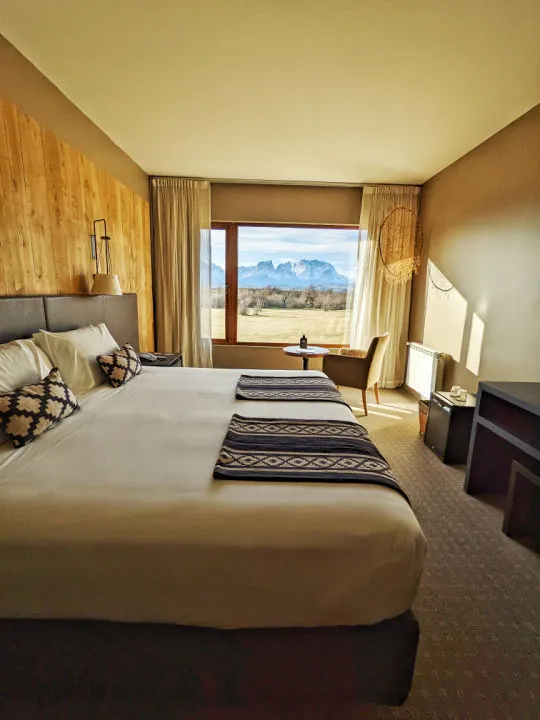
Part of the appeal of this hotel is its facilities, which include a stunning pool with similarly spectacular views, plus an ample spa, with a sauna, gym and rooms for massages and other treatments.
There are also cosy reading areas on the ground floor, plus a large restaurant. They do offer a limited number of excursions, but these are only available at an additional cost.
Pampa Lodge
For a much quieter stay, the nine-bedroom Pampa Lodge ($320 USD double with breakfast) has similarly compelling views of the Paine Massif from the large windows of its understated bedrooms. A small outdoor terrace allows you to enjoy the surroundings with a pisco sour in hand after a busy day on the trail, while their on-site restaurant serves up classic Chilean dishes.
It’s also located just a short drive from Portería Serrano, making it a great spot just outside the park. If you’re on more of a budget, Pampa Lodge Refugio offers dorm accommodation in pleasant bedrooms, with breakfast included and access to the hotel’s restaurant.
Guests of both can join horseback riding excursions for an additional fee.
The best low-budget accommodation in Torres del Paine
Torres del Paine isn’t an easy place to visit on a budget, particularly as public transport is poor and you’ll need to either bring your own transportation or be open to hitchhiking. Hotels are at a much higher cost than otherwise found in Patagonia, so the most budget-friendly choice is at one of the campgrounds.
Camping Pehoé
One of only two campgrounds in the national park that aren’t part of the W or O trek, Camping Pehoé ($12,000 CLP pitch pp, $100,000 CLP double dome) is a great budget choice that’s located within the park’s boundaries.
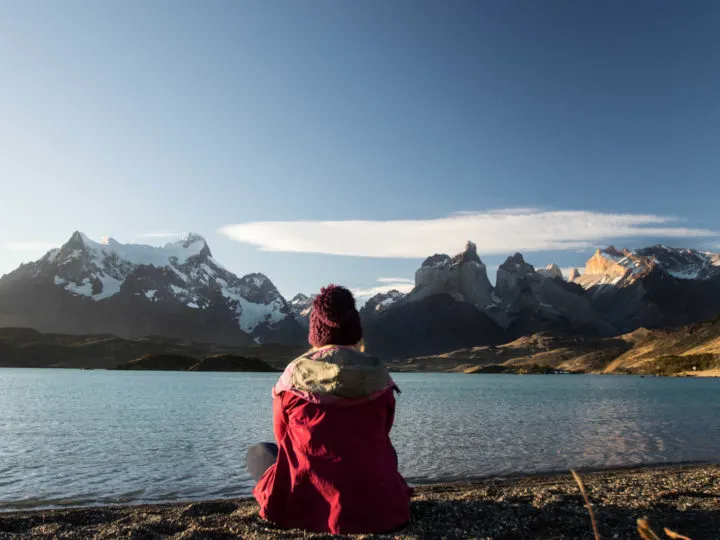
A 10-minute drive south of the Pudeto catamaran ferry stop (where many start the W trek) and within a 45-minute drive of the trailhead for the Mirador Las Torres hike, this campsite has 40 pitches, hot showers and is very well-located, with its own restaurant (open to the public) right next door.
You can either pay for just a pitch, a pitch with hired tent and sleeping bag or a dome (these come with a sleeping bag and blanket). Pitches have roofed structures to protect your tent from Patagonia’s notoriously strong winds, plus a table and a barbecue (they sell firewood).
You can also pay for boxed lunches for when you’re out on the trail and there’s a small grocery store here if you need to stock up on basics.
Torres Central camping and refugio
While Torres Central camping and refugio ($25 USD pitch pp), which is situated right at the trailhead for the Mirador Las Torres hike, is used by campers along the W and O treks, it’s also a good spot if you’ve got your own transportation and want an affordable place to stay.
It’s one of the biggest in the whole park, which means it often has space available for campers – even if you’re quite last-minute with your reservations. They can provide meals through their restaurant, which you generally need to book in advance but can sometimes it’s possible to arrange this on the day if you’re lucky.
There’s also a small grocery store and every pitch has access to hot showers and Wi-Fi at an additional cost.
Camping Kau Laguna Azul
Right on the other side of the national park beside Laguna Azul, Camping Kau Laguna Azul ($36 USD tent and sleeping bag pp) is another very affordable choice for accommodation in Torres del Paine. It’s a 30-minute drive north of Portería Laguna Amarga in the northeast side of the park, but still well-placed for driving to the main sights.
There’s a small cafe on-site for basic meals, as well as access to a large kitchen/dining area for preparing your own food. There are no charging points, so bring battery packs for key items and plenty of warm clothing.
The best Torres del Paine tours
If you’d rather explore the national park with a guide but don’t want to fork out the high rates charged by the park’s luxury, all-inclusive hotels, taking a multi-day tour from Puerto Natales into the national park is a great compromise.
All of the tours I recommend are with Chile Nativo, an outstanding local operator with whom I’ve been proud to work for a number of years. They offer Worldly Adventurer readers a 5% discount if you add “Worldly Adventurer” to the referral discount box when you book!
Torres del Paine five-day multisport adventure
I recently came back from exploring the national park for the third time. On this occasion, I joined Chile Nativo’s five-day Torres del Paine multisport tour (from $2,295 USD pp), which included a wealth of activities around the national park, such as kayaking on Lago Grey and trekking to the Mirador Las Torres and through some of the lesser-known parts of the national park.
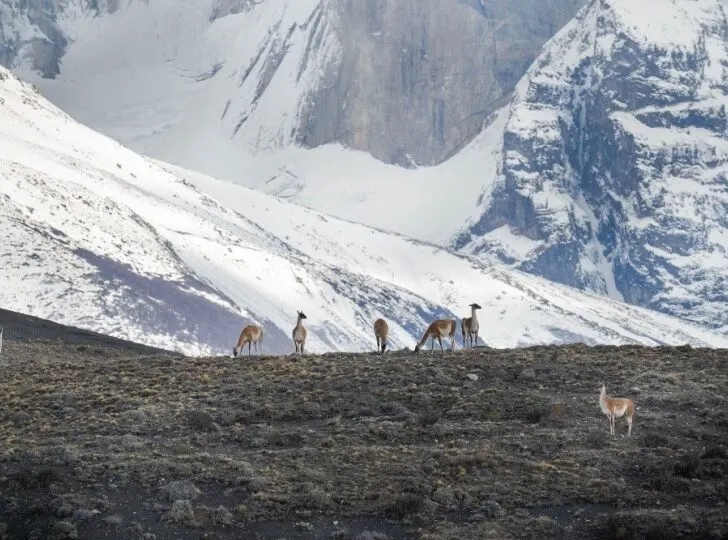
At night, we stayed in the comfy yurts at the Riverside Camp, which sits on the Río Serrano and, much like the expensive hotels mentioned above, has incredible views of Los Cuernos.
Transportation, accommodation and all meals are included (the latter giving you a taste of classic Chilean dishes prepared exquisitely) and Chile Nativo’s guides are second to none. You can also opt for a three-day multisport tour (from $1,795 USD pp) if you’ve got a shorter window of time for the park.
Discovering Torres del Paine tour
If you’re keen on a soft adventure in Torres del Paine, Chile Nativo’s five-day discovering Torres del Paine tour is a better choice. Staying in hotels in the national park, this tour takes you to the park’s highlights. These include some of the best viewpoints around the national park, by boat to see Glacier Grey, on a guided tour of the nearby Milodon Cave, and on other trails in the park to observe wildlife, including condors and guanaco.
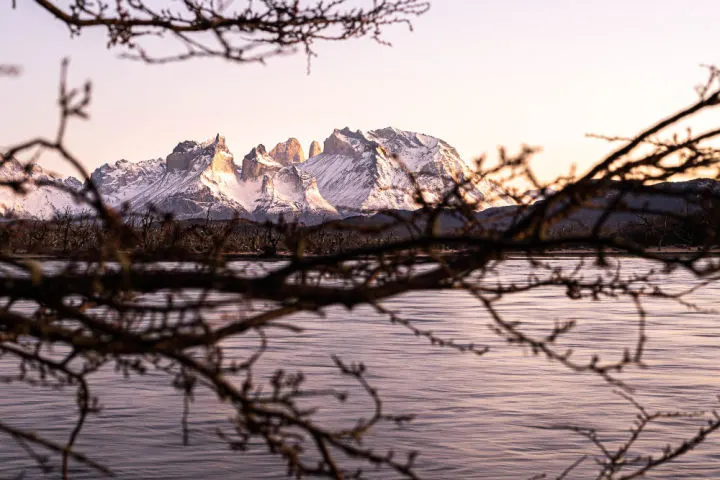
Again, transportation, accommodation and all meals are included, with lodgings in three of the park’s high-end hotels.
Wildlife and landscapes in Torres del Paine photo safari
Torres del Paine National Park is a destination that has been drawing photographers in their droves for decades and it’s not hard to see why. If you want to spend five days capturing this pristine part of Patagonia through your lens then Chile Nativo’s Torres del Paine photo safari ($2,495 USD pp) is the ultimate way.
You’ll get to embark on a puma tour to discover the big cats in their natural habitat, as well as catch each and every sunrise and sunset from different places around the park. Along the way, you’ll keep your eyes peeled for native wildlife, including foxes, flamingoes, and condors, and have the opportunity to capture the park’s most dazzling landmarks, too.
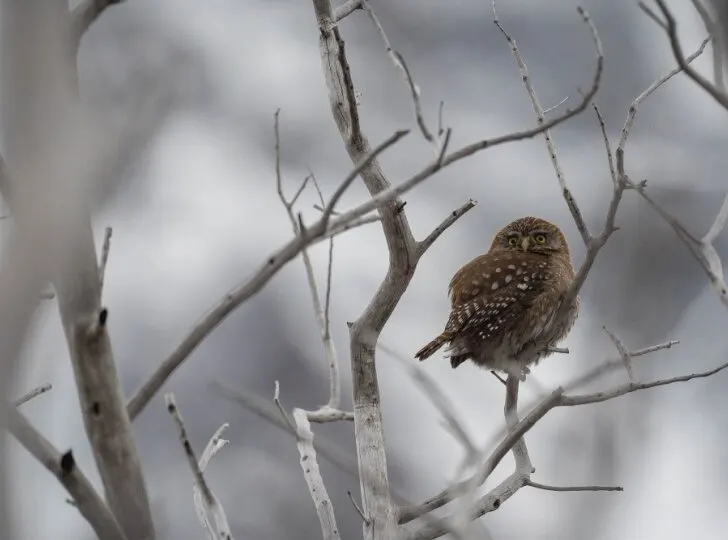
Again, transportation, accommodation and all meals are included. You’ll stay in their cosy Riverside Camp on the banks of Río Serrano.
Hunting for fossils in Torres del Paine
With landscapes dating back millions of years, it’s no wonder that Torres del Paine National Park is packed with fossils from this bygone time. Chile Nativo’s brand-new hunting for fossils tour takes you far beyond-the-beaten trail into the barely-visited Zapata Valley. Here, Ichthyosaurus fossils and remote glaciers clinging to the Southern Patagonian Ice Field await.
This tour makes the perfect combination with the W trek, as it’ll give you the chance to bid farewell to the busy trails of the national park and head into an area where few tourists go.
Again, transportation, accommodation and all meals are included, with accommodation taking the form of a local ranch and wild camping.
How can you visit Torres del Paine National Park sustainably?
I’m always keep to lower the impact of my visit when travelling – and particularly when I’m spending time in destinations that run the risk of falling victim to over-tourism.
Torres del Paine National Park is one of South America’s most visited destinations, with over 300,000 tourists exploring its spectacular landscapes each year. Every visitor, consciously or not, leaves their mark on the trails and ecosystems found within the park.
As a result, it’s all of our responsibility to consider how we can best tread lightly and ensure the park remains pristine and ready to receive careful visitors for generations to come. Here are some of the best ways to explore Torres del Paine sustainably.
Stay longer
While it’s possible to see the park on a whistlestop day tour from Puerto Natales or even El Calafate, to truly appreciate its sensational scenery and special wildlife, a longer trip is better.
Lengthening your stay to three or four days (and your trip to Patagonia to as long as possible) will see you spending more money that goes into local pockets (particularly if you follow the suggestions below) and lowers your travel footprint, too, by reducing your emissions.
Stick to trails and leave no trace
Trails along the W trek in particular have widened through the years as more hikers have hit the route and, increasingly, deviated from the main path. This is sometimes caused by poor weather conditions (muddy paths can be very challenging to follow) and also as trekkers meet others on the trail.
However, it’s still essential to stick to the marked paths and, as ever when hiking, leave no trace. That means no rubbish, no toilet paper and certainly no fires – the latter of which have, historically, been caused by irresponsible visitors, resulting in devastating fires that have damaged thousands of hectares of pristine national park lands.
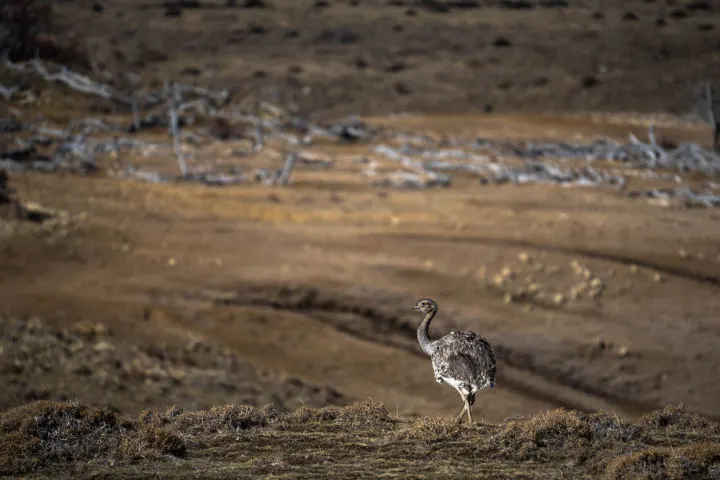
Explore lesser-visited areas
While I’ve hiked both the W and the O, what I realised on my most recent visit to the park is how much more there is to see and do beyond these two ubiquitous hiking routes.
Opting for some of the lesser-visited day hikes that take you far beyond where other visitors ever go within the national park is a great way of spreading the impact of tourists. It also enhances your experience; you’ll see Patagonia at its most pristine and, more importantly, silent.
Camp rather than stay in a hotel
While the luxury hotels in the national park are a very pleasant way to while away an evening in the park, the most sustainable places to stay are in one of the glamping sites (such as Patagonia Camp and Chile Nativo’s Riverside Camp) or straight-up camping. This is because these locations can theoretically be dismantled without leaving damage to the environment and the water use is typically lower, too.
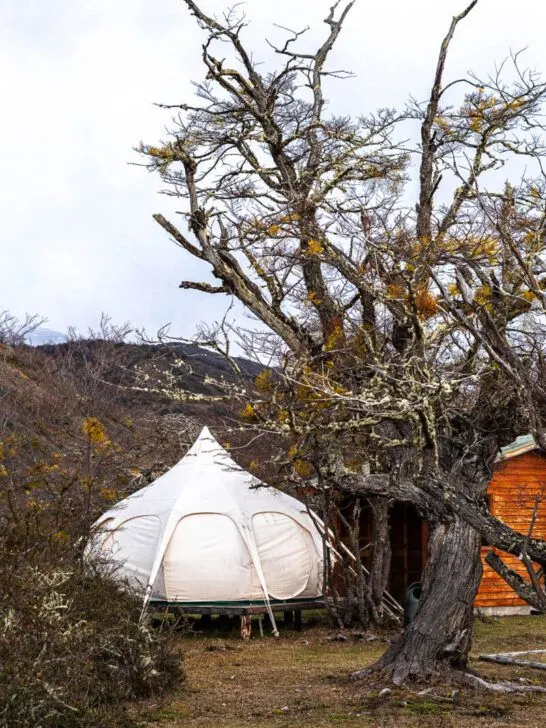
If you’re still set on staying in a hotel, then consider donating to the Torres del Paine Legacy Trust, a nonprofit that supports conservation projects in the park, as well as community development initiatives in the wider area
Reach Patagonia by boat rather than flight
Flights are the quickest means of getting to Patagonia, covering the thousands of miles separating Torres del Paine from Santiago and Buenos Aires in a few short hours. However, if you’re coming from anywhere else in Chile, the most sustainable means of reaching the park is aboard one of the public ferries that sail to nearby Puerto Natales.
You’ve got two options: the four-day, three-night Navimag ferry from Puerto Montt (at the northern tip of the Carretera Austral) or the 41-hour TABSA ferry from Caleta Tortel (at the bottom of the Carretera Austral). Both are an incredible opportunity to see the sublime landscapes of the Patagonian fjords slowly and without the carbon impact of a short-haul flight.
Take a tour or public transport rather than hiring your own vehicle
Exploring the length and breadth of Torres del Paine is made more challenging by limited public transport, which has been designed to ferry passengers from Puerto Natales to the trailheads for the W and the O (as well as a handful of other places in the park).
However, the carbon footprint of thousands of vehicles a day entering the national park is one that doesn’t fit with a sustainable approach to Patagonia. As a result, it’s far more eco-friendly to travel either by public transport (again, only for the W and the O as it’s not designed to get you between sights or trailheads) or as part of an organised tour or all-inclusive package.
I highly recommend all of those offered by Chile Nativo, but the higher-end hotels also offer these services.
Book directly through a local tour operator
As part of my own commitment to you, my reader, and to the travel industry as a whole in Latin America, I only work with companies that I know are doing a brilliant job in their respective destinations across the continent. Not only does this ensure that you get a quality experience if you book a tour I recommend (not something that’s guaranteed through faceless companies such as Viator and GetYourGuide), but it also means I can directly support local companies.
Therefore, if you do decide to visit Torres del Paine National Park as part of a tour, then book directly with the local companies based there.
Chile Nativo is my chosen local partner because they’re recognized across the industry for the excellent work they do to support sustainable tourism in Patagonia, and they deliver fantastic service to tourists, too. They offer Worldly Adventurer readers a 5% discount if you add “Worldly Adventurer” to the referral discount box when you book!

Grant
Friday 8th of March 2024
The bus schedules posted for buses from Port Natales to Torres del Paine were super useful. Please be aware that if your ticket says a particular time and bus stop you may be able to get on that bus at another stop. Also be aware that the time could be up to two hours different at another stop (mine was!).
Steph Dyson
Sunday 10th of March 2024
Thanks for this info Grant! Steph
Karolina
Friday 19th of January 2024
Hello,
I would like to visit with my friend Torres del Paine in February 2024 and do this one day trekking to the Mirador Base Torres and return to Puerto Natales. I have checked bus from Puerto Natales. The earliest leaves at 6:50 and arrives at Laguna Amarga at 8:50. I am a little bit confused because I could not receive exact information ( answer depended on the person who replied me). Once they said from that there is only one shuttle bus at 8:45. The other person that there are shuttle buses each 30min or 1 hour. On blogs I have read that there are shuttle buses synchronised with Bussur from Puerto Natales. What is the truth? And what about the return?
Do shuttle buses go all the time during a day from Laguna Amarga to the Welcome Center and return? And no matter what time we will be in Laguna Amarga there will always be shuttle bus? And maybe do you know till which hour in the evening shuttle buses are available? I would like to have Bussur from Laguna Amarga around 20:00 or 20:30. So around 20:00 there will be also some shuttle buses from the Welcome Center?
I would be very grateful for the answer.
Steph Dyson
Friday 9th of February 2024
Hi Karolina, Las Torres Hotel (who run the shuttle) said that the shuttles are there to connect with the bus that gets in at 8.50am. I'm not aware that there are continuous shuttle buses to and from Laguna Amarga and the Welcome Centre; she said that there are specific times per day when these run. Steph
Mitch Wilenchik
Thursday 4th of January 2024
Hi Steph, I have a question. I am staying in puerto Natales the night before hiking Mirador las Torres. Can I get in the park earlier than the official opening time? I’d like to start the hike by 7 am if possible to beat the crowds but not sure if the gate is open to enter that early. Thanks for your comprehensive article! Best regards, Mitch
Steph Dyson
Sunday 14th of January 2024
Hi Mitch, I'm not actually sure but I think so. You can email CONAF to find out. Steph
Rollie
Monday 27th of November 2023
Hi, my wife and I are going to do the O hike in March as part of a longer SA/Antarctica trip, so we will need a place to store some of our luggage while we are on the O hike. Any suggestions for places to store luggage in the park or in Puerto Natales? Thank you!
Steph Dyson
Tuesday 28th of November 2023
Hi Rollie, most hotels in Puerto Natales will let you store you're belongings while you're in the park. Steph
Elizabeth
Wednesday 6th of September 2023
You don't mention this in your BA to Torres section, but it looks to us like it might be feasible and cost-efficient to fly BA-Santiago-Puerto Natales with LATAM, as a way to get closest to Torres. Is there anything against this? One con may be that it looks like you have to spend a night in Santiago.
Steph Dyson
Wednesday 20th of September 2023
Hi Elizabeth, that normally adds a lot to the cost but yes, is a viable option. Steph